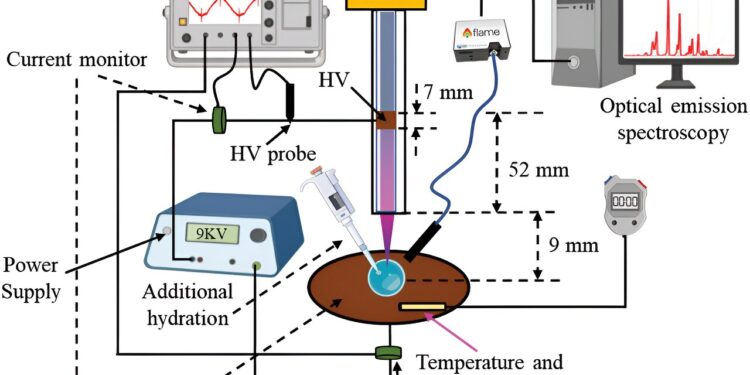Experimental device for activating PVA hydrogels with a helium plasma jet. Part of this image was created with biorender.com and bioiconics.com. Credit: Advanced functional materials (2024). DOI: 10.1002/adfm.202314345
A team of international scientists has developed a more effective treatment for chronic wounds that involves not antibiotics or silver-based dressings, but an ionized gas called plasma.
The treatment involves stimulating plasma activation of hydrogel dressings with a unique blend of different chemical oxidants that decontaminate and help heal chronic wounds.
Dr Endre Szili, a physicist from the University of South Australia who led the study published last week in Advanced functional materialsdescribes the new method as “a significant advance” that could revolutionize the treatment of diabetic foot ulcers, internal wounds and potentially cancerous tumors.
“Antibiotics and silver dressings are commonly used to treat chronic wounds, but both have drawbacks,” says Dr. Szili. “Increasing resistance to antibiotics is a global challenge and silver-induced toxicity is also of great concern. In Europe, silver dressings are being phased out for this reason.”
More than 540 million people worldwide live with diabetes, 30% of whom develop a foot ulcer during their lifetime. The cost of managing chronic wounds such as diabetic foot ulcers already exceeds $17 billion per year and this cost is expected to rise in coming decades as obesity and lack of exercise drive more cases .
The benefits of cold plasma ionized gas have already been proven in clinical trials, showing that it not only controls infections but also stimulates healing. This is due to the powerful chemical cocktail of oxidants, namely reactive oxygen and nitrogen species (RONS), that it produces when it mixes and activates oxygen and nitrogen molecules present in Ambiant air.
Dr. Szili and colleagues showed that plasma-activating hydrogel dressings with RONS make the gel much more potent, killing common bacteria.
Although diabetic foot ulcers are the focus of this study, the technology could be applied to all chronic wounds and internal infections.
“Despite recent encouraging results in the use of plasma-activated hydrogel therapy (PAHT), we were faced with the challenge of loading hydrogels with sufficient concentrations of RONS required for clinical use. We overcame this obstacle by employing a novel electrochemical method that enhances hydrogel activation. “.
In addition to killing common bacteria (E. coli and P. aeruginosa) that cause wound infection, researchers say plasma-activated hydrogels could also help trigger the body’s immune system, which may help to fight infections.
“Chronic wound infections are a silent pandemic that threatens to become a global healthcare crisis,” says Dr. Szili. “It is imperative to find alternative treatments to antibiotics and silver dressings, because when these treatments do not work, amputations often occur.”
“A major advantage of our PAHT technology is that it can be used to treat all wounds. It is an environmentally friendly treatment that uses the natural components of air and water to produce its active ingredients, which degrade into non-toxic and biocompatible components. “
Dr. Szili says that in the future, plasma could be used to treat cancerous tumors by activating drugs in gels injected into the body.
“Active ingredients could be delivered over a long period of time, improving treatment, with a better chance of penetrating a tumor.
“Plasma has enormous potential in the medical world, and this is just the tip of the iceberg,” says Dr. Szili.
The next step will involve clinical trials aimed at optimizing the electrochemical technology for the treatment of human patients.
More information:
Sumyea Sabrin et al, Electrochemically enhanced antimicrobial action of plasma-activated poly(vinyl alcohol) hydrogel dressings, Advanced functional materials (2024). DOI: 10.1002/adfm.202314345
Provided by the University of South Australia
Quote: Scientists develop more effective treatment for chronic wounds with plasma-activated hydrogel dressings (February 19, 2024) retrieved February 19, 2024 from
This document is subject to copyright. Apart from fair use for private study or research purposes, no part may be reproduced without written permission. The content is provided for information only.



